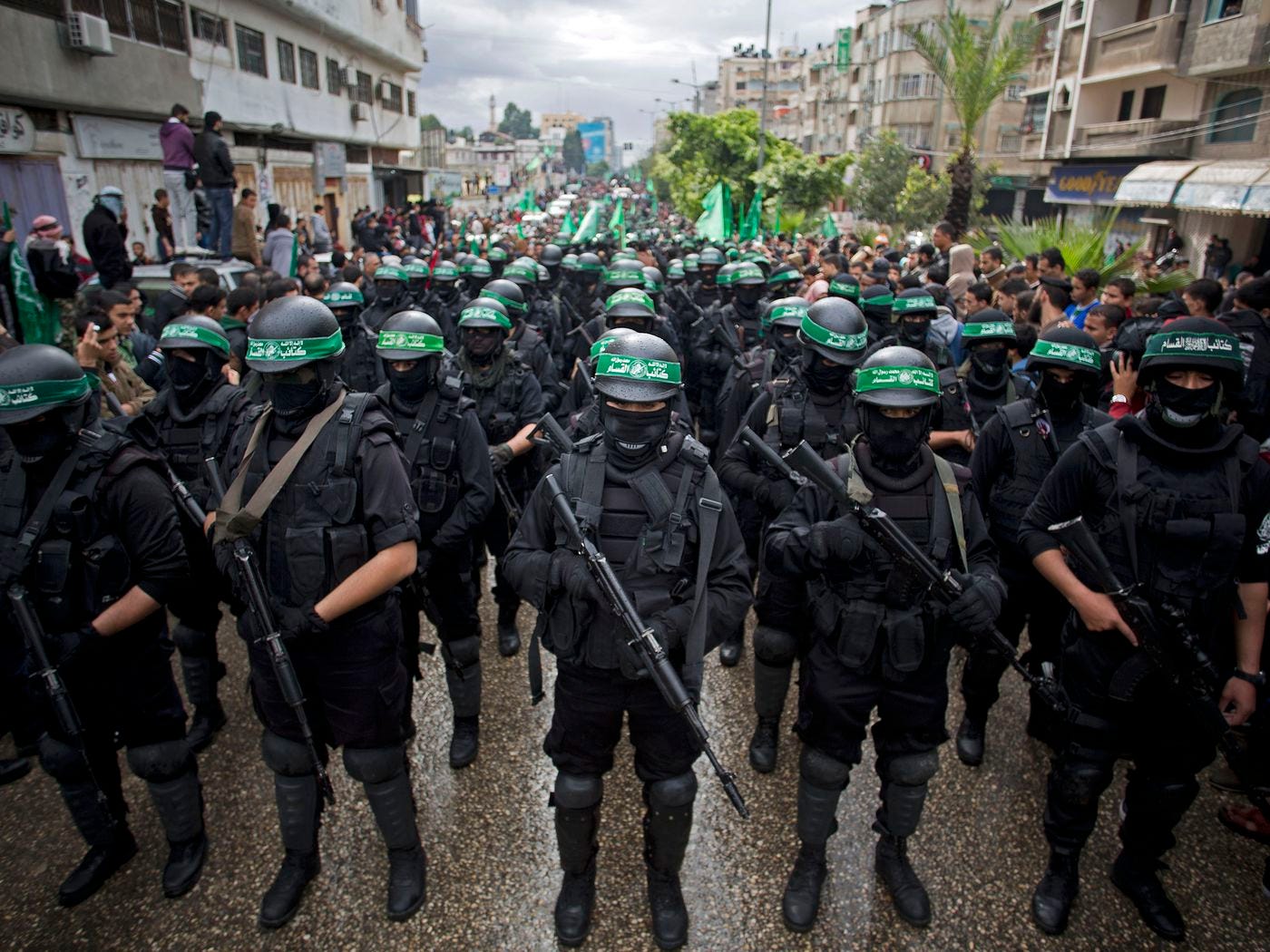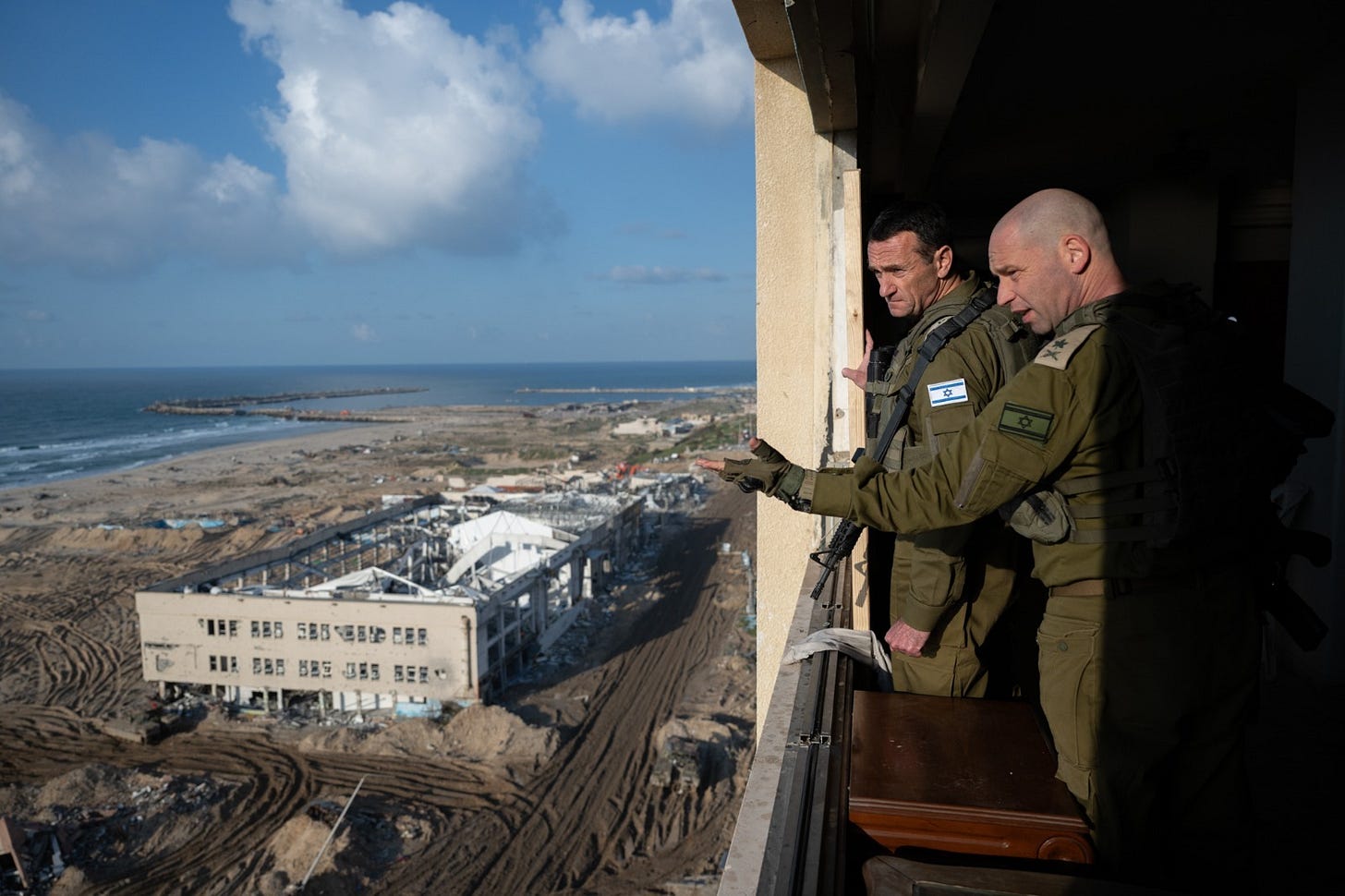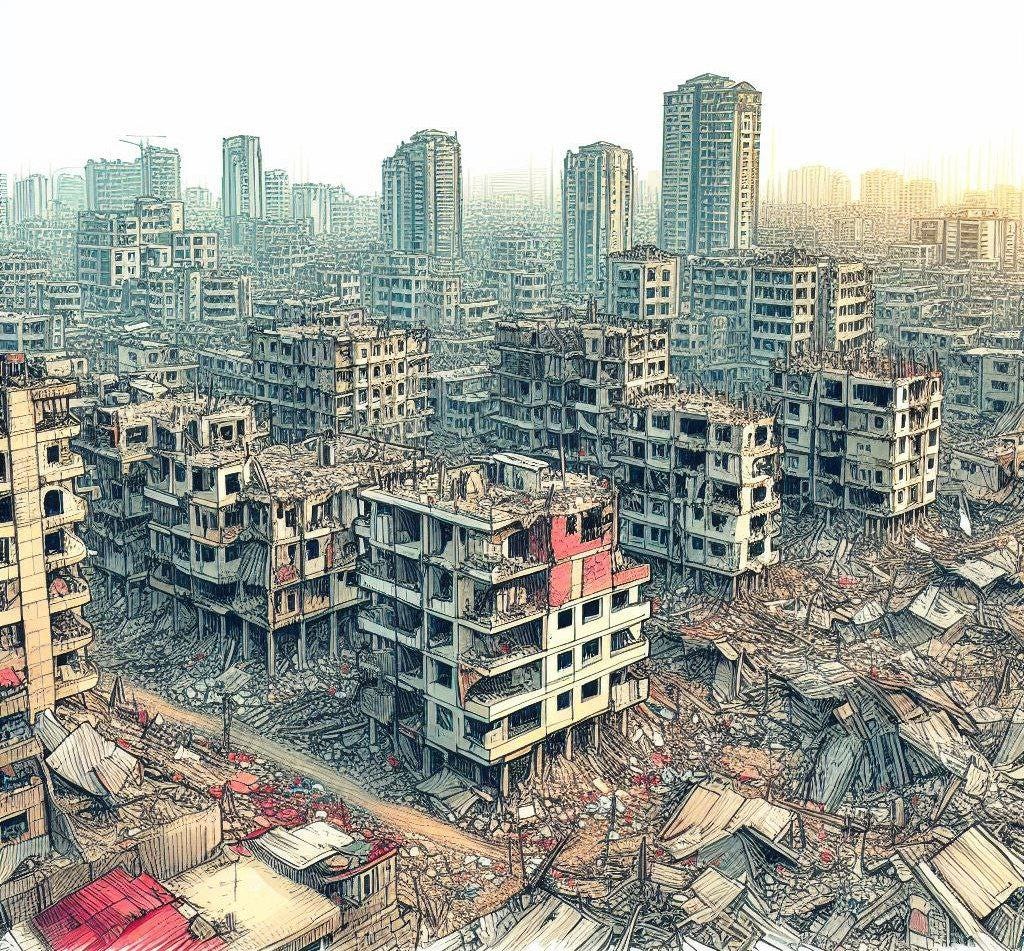We are now four months into the Israel-Hamas war which began on October 7th. Gaza is now in the ruins, with most of its buildings destroyed or damaged by the Israeli army. Hatred on each side of the conflict is as great as it has ever been, as is anti-Zionist sentiment outside Israel after months of Israel’s campaign. The world has Israel fatigue, as do Joe Biden’s supporters. It is now plausible that Israel’s actions in Gaza could actually cost him enough support to cause him to lose his re-election campaign. Now, Israel is entering what it says is the final phase of its operation in Gaza: an assault on the southern city of Rafah which is shaping up to be another bloodbath. The conflict has to come to an end soon, but what would that look like? I am going to take a look at the four possible outcomes of this war, and how likely I believe each is.
Greater Israel
This is the strategy advocated for by hardliners in the Netanyahu government like Itamar Ben-Gvir and Bezalel Smotrich, and increasingly favoured by the Israeli public. In 2017, a young Smotrich put forward the “Decisive Plan”, a kind of manifesto for extreme Zionists unwilling to tolerate any Palestinian statehood. Smotrich discusses the ”demographic challenge” posed by the existence of Palestinians – his solution? Completely annex the West Bank and give Palestinians there a choice: accept a status as second class citizens in a Greater Israel or leave. After this ultimatum, Smotrich – now the Israeli finance minister – advocates using the Israeli army to slaughter any remaining resistors, including women and children. Smotrich justified this secondary status for Arabs with reference to Judaic law: “according to the Halacha, they should always be a little inferior”, explaining that non-Jews who remain in Israel should not only be second-class citizens, but subject to ongoing humiliation: “so that they will be despised and humiliated, and will not raise their heads up against the Jewish People”.
Since the latest Israel-Hamas war, Smotrich has joined other Israeli government members in calling for the complete expulsion of Palestinians from Gaza as a final solution to the Gaza problem. Israel hasn’t done great on the PR front since October 7th, and calling this plan for ethnically cleansing “voluntary migration” hasn’t made their advocacy of ethnic cleansing be any better received, drawing condemnation from leaders in the West, even their closest ally. It’s a sign of how extreme the Israeli government has gone that this idea is being seriously considered at the highest levels, with the Israeli Ministry of Intelligence officially recommending expulsion in October.
The problem for Israel, though, is where would the 2 million Palestinians in Gaza go? As Israel plans a new offensive on Gaza’s southern city of Rafah, Egypt has stepped up its security by deploying more of its military to the border. Egypt has refused to budge on keeping its border shut to Gazans, partly because the Egyptian public is well aware that Israel would like to give them the refugee burden to facilitate a second Nakba, and the Egyptian government fears hosting the Palestinian population would drag their country into the conflict.
Israeli government members have tried advocating “voluntary resettlement” to the West in Western media outlets, and most have put a better face on this dismal proposal for ethnic cleansing than Israel’s Heritage Minister, who said Palestinians could go to “Ireland or deserts”, but there is only so much hardline Zionists can do to present their desire for Greater Israel as a humanitarian solution. Not only have Western leaders shot this down, but the Western public has no appetite for it. For the anti-Zionist left, this is transparently aiding an ethnic cleansing, and to people on the right sympathetic to Israel, this is being asked to take two million people they have been told are genocidal Islamists.
De-Hamasification
Netanyahu’s stated aim for Israel’s war in Gaza is to totally eradicate Hamas, demilitarise Gaza, and deradicalise its population. The claim of the Israelis is that October 7th was just the latest horror caused by a population that has been radicalised into extreme Jew-hatred by a terrorist organisation, and no progress can be made toward any lasting peace until the generations of indoctrination Gazans have experienced is undone. According to Israeli Professor Elihu D Richter:
What is required is the complete removal and replacement of these systems, which must be enforced from the top down, accompanied by close supervision and monitoring. The best example of this approach is what was done in Germany at the end of WWII. When the Allies liberated Germany, they took over its legal, educational, political, and cultural environment. The official term for this comprehensive approach was denazification, and it proved to be effective.
Israel obviously overwhelms Hamas militarily, and has inflicted huge casualties on the group since the start of the war, but what would really defeating Hamas look like? This isn’t clear. The raw kill count of Hamas militants doesn’t tell us much. There are over two million people in Gaza, half of them are men, and most are young. As long as the current occupation abides, there is going to be a good portion of them taking up arms against the state of Israel, and the destruction wrought by Israel in this round of the conflict has likely radicalised new sections of the Gazan population into a willingness to take up armed resistance.
Even if Israel succeeds in destroying Hamas’s military infrastructure and extensive tunnel system, it will not destroy Hamas as a political or ideological force. The group’s leadership can survive abroad, namely in Qatar or Turkey, and will retain enough legitimacy among Palestinians to reconstitute itself or act through intermediaries. Perhaps removing the leadership through assassinations would be sufficient, as Israel has pledged to do. This would likely be more difficult than killing most Hamas members. Israel’s infamous assassination campaign carried out after the Munich Olympics attacks in the 1970s were focused in Europe, but senior Hamas leaders are living safely in Qatar and Turkey. Turkish President Erdoğan has already warned Israel of “extremely serious” consequences if it carries out assassinations within Turkey, while Qatar has served as an intermediary in negotiations around hostage exchanges and received assurances assassinations will not be carried out on its soil. The Hamas leadership within Gaza, meanwhile, has a friendly population to offer them cover. If Israel did track down and kill these leaders, it would be a strong propaganda victory, and offer them a chance to claim success in their campaign, but how much would this undermine the existence of Hamas? After almost two decades governing Gaza, Hamas is now deeply embedded in all aspects of Gazan society, and presumably has ample reserves of candidates to draw new leadership from.
Real de-Hamasification then, would require a long-term, massive occupation and intense surveillance on all of Gaza, and a liberal use of force on any men suspected of siding with Hamas. But cutting off the lifeblood of the organisation would require undermining support for its ideology among Gazans, and what would this require? The most recent polls on Palestinians show that everything since October 7th has just increased support for armed resistance. A poll published in December showed that 57% of Palestinians in Gaza supported the October 7th attacks, and support for Hamas itself had also increased. If the West hoped Hamas could be overturned by more moderate nationalist leaders it is as concerning that 90% polled wanted Mahmoud Abbas, leader of the Palestinian Authority, to resign.
A replacement for Hamas would not only have to be acceptable to Israel, meaning removing its competing claims for territory, but also receive enough support from residents of Gaza to be legitimate, and be capable of defeating remnants of Hamas support for control of the strip. It’s hard to envision what kind of movement could arise capable of achieving all this. In practice, what this means is we probably won’t see a clean end to the war but a cycle of ceasefires and renewed offensives. Each pause will be presented as a breakthrough, only to collapse under the same pressures that produced the conflict in the first place. Hamas only needs to survive to claim victory, and eventually the external costs for Israel of proceeding with its pledge to wipe them out without a negotiated settlement will become too great.
Gaza Prison Camp
Recent analysis of satellite images have shown Israel is demolishing everything with a kilometer-wide range, destroying everything from homes to farmland in what is likely the creation of a buffer-zone between Israel and Gaza. A spokesman for Netanyahu has spoken of “the establishment of a temporary security zone along the Gaza border with Israel” as part of a broader demilitarisation of Gaza. Regardless of other outcomes, weakening the capacity of forces in Gaza to ever pull off another event like October 7th is the absolute minimum for Israel, and if they cannot succeed in deradicalising the population there, they can still resort to a more aggressive version of the tactics they have been using since starting a blockade on the territory in 2007. This would mean continuing to enforce the blockade, destroying the Hamas tunnel system, more aggressively surveilling the region and assassinating militants, and establishing a formidable buffer-zone which no future militant group could cross.
The buffer-zone, like much of the other infrastructure of Israeli oppression, would likely be advertised as temporary but become a fixture. Further enclosing the population of Gaza into an even smaller region, and wiping out their homes and farmland will lead to further radicalisation and a desire for revenge, and it could only be policed with extreme violence. Jacob Nagel, a former advisor to Netanyahu, predicted the “killing zone” would have to be enforced by having Israeli soldiers fire live rounds on anyone who enters: “I like to call it a ‘killing zone,’ but since ‘killing zone’ is not a nice term, we use the words ‘buffer zone”. Other senior Israeli figures have suggested filling it with landmines to keep Palestinians out.
Typically, concerns for the consequences of violating human-rights laws might hold a state back from a project like this, but anything is possible with the ongoing support of the United States, and presumably anything can be excused as a temporary means of protection for Israel as long as everyone keeps promising to work toward a lasting peace. While the international community may not be willing to facilitate Israel’s desire for a mass-expulsion, Israel can continue to use the justification of fighting terrorism as it enacts effective means of occupation to cripple Palestinian armed resistance.
Two States
Given the barbarism witnessed in recent months, it may seem fantastical to suggest this conflict could lead to a lasting peace in the long hoped for two-state solution. Yet while it’s true Israelis and Palestinians now hate each other more than ever, it’s also true that the world is now more committed than ever to creating a more sustainable peace. The US has long been pushing for its ally Saudi Arabia to normalise ties with Israel, but now the kingdom is declaring it a precondition that there be a Palestinian state on the 1967 borders. While there is seldom any distance between the wishes of the Israeli and American governments on policy in the region, there is some indication the Zionists running the American government might be willing to push their unruly cousins in Tel Aviv toward a better optics resolution which includes Palestinian statehood, especially if the Saudis are driving a hard bargain. There has been talk of a “grand bargain” by the US State Department involving normalisation of Saudi-Israeli ties coupled with a credible path to a Palestinian state.
Recently, a State Department spokesperson claimed the US was “actively pursuing the establishment of an independent Palestinian state” after the war in Gaza. Speaking to an Israeli audience a week later, US Secretary of State Antony Blinken laid out his vision of:
An Israel that’s fully integrated into the region, with normal relations with key countries, including Saudi Arabia, with firm guarantees for its security, alongside a concrete, time-bound, irreversible path to a Palestinian state living side by side in peace and security with Israel, with the necessary security assurances.
The next day, Biden for the first time offered criticism of Israel’s response in Gaza, calling it “over the top” and suggesting the US will push for a ceasefire.
The two-state solution is backed, at least in theory, by Biden. It has been backed by UN resolutions. Alongside Saudi Arabia, it has the support of Egypt, Jordan and America’s allies in the gulf states. This war has shoved the question of Palestine in the faces of these countries, and anti-Zionist sentiment is hotter than ever in the Middle East.
The problem, of course, is Israel. For decades, it has primarily been Israeli unwillingness to allow it that has prevented progress to a two-state solution. Their government and the fanatical settlers have made this as unfeasible as possible: there are now over 500,000 Israeli settlers living on Palestinian land in the occupied West Bank, and a further 229,000 in occupied East Jerusalem.
Netanyahu requires the support of fanatical settler activists in his government who believe every inch of Palestine belongs to them and will never tolerate serious talk of a Palestinian state, and, more troublingly, the Israeli public is increasingly seeing things their way. A poll conducted in December found that only one in four Israelis now support a two-state solution, with 65% opposing it, “almost a complete reversal of where they stood on the issue a decade ago”. The prospects are no better when we look at Israel’s demographics: Israeli youth are far more right-wing than their parents and grandparents, increasingly identifying with the ultra-Zionist factions in Israeli politics. The Ben-Gvir and Smotrich types are assured of a strong support base for decades to come of young Jews who expect no rapprochement with the enemy.
Conclusion
It’s hard to envision a way Israel can achieve its stated aim of eliminating Hamas in anything but name. The people of Gaza will not forget the stories of the Nakba their parents tell them, nor will they forget the horrors wrought by the IDF since October. Both sides of the conflict are being further radicalised with no end in sight. As long as these conditions persist, groups like Hamas will retain support in Gaza, and as long as they do, Israel will have its security excuses for making no progress toward a two-state solution and continuing its own policies which contribute to undermining the possibility of a future Palestinian state.
The US may become more willing than ever to push for a lasting resolution that is not just a continuation of the Greater Israel policies it has been supporting materially, but this is happening alongside a trend of the most radical, genocidal Zionists entering the mainstream of Israeli politics and winning popular opinion. Unless the US takes an extremely hard line with the Israelis, they will continue what they have been doing, and this cycle will continue. No Palestinian state or a philosemitic, de-Hamasified Gaza, but more military installations, more settlements, a North Gaza “killing zone”, a Palestinian population in the West Bank more willing to embrace armed struggle in support of their brothers in Gaza, and an Israeli population demanding a more extreme response. It all points to decades more of the horror show we have been witness to since October 7th.
Ultimately though, this chapter of the conflict will end when Israel’s political leadership calculates that the marginal cost of continued occupation exceeds the deterrent value of victory. This calculation will arrive slowly, under the weight of isolation, international pressure and domestic unrest








It has become rare to see any insightful analysis on the Israel-Palestine issue in the past few months. The usual players (especially NYT and WP) have all but abdicated all responsibility by strictly toeing the Israeli/Zionist line, which is being even more diligently policed now. Glad to the gap being filled by bright, young people such as yourself, Keith. Well done and keep it up!
P.S. It would be interesting to hear your take on the anti-UNRWA campaign by Israel, particularly within the context of Israeli officials' calls for resettling Palestinians in Europe.
The "two-state solution" has always been fake, something cynically designed for gullible white people in the West, just like the "peace process." An excellent book to get up to speed on this stuff is Ilan Pappé's Ten Myths About Israel. The only progressive solution is a single secular state with everyone living together with the full right of return for refugees, from the river to the sea.